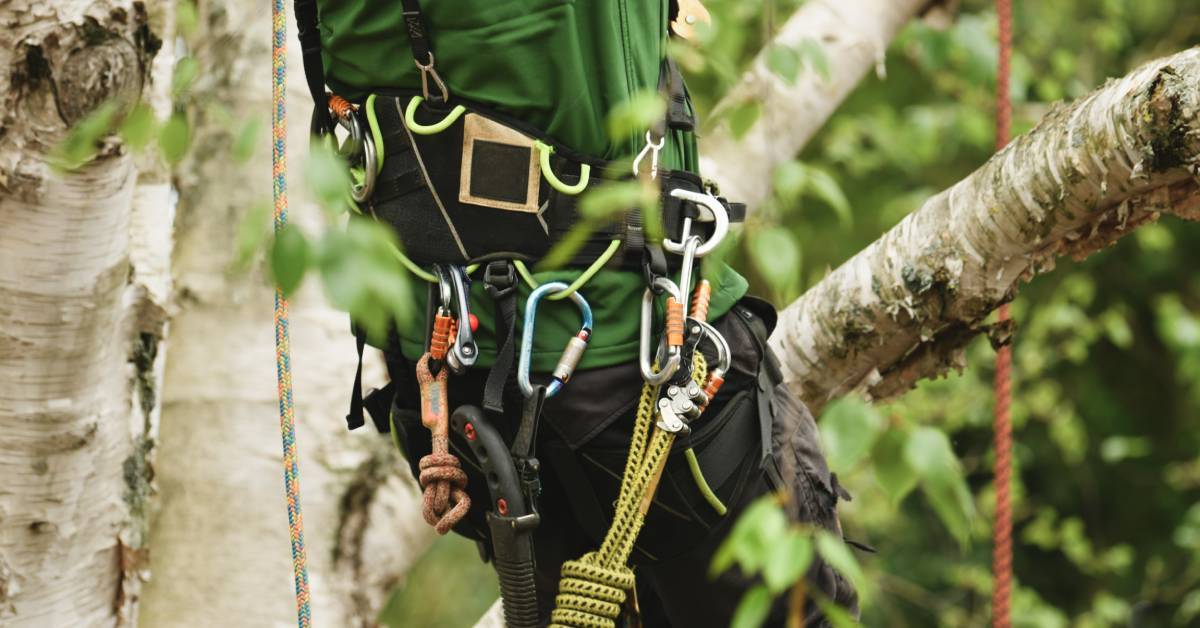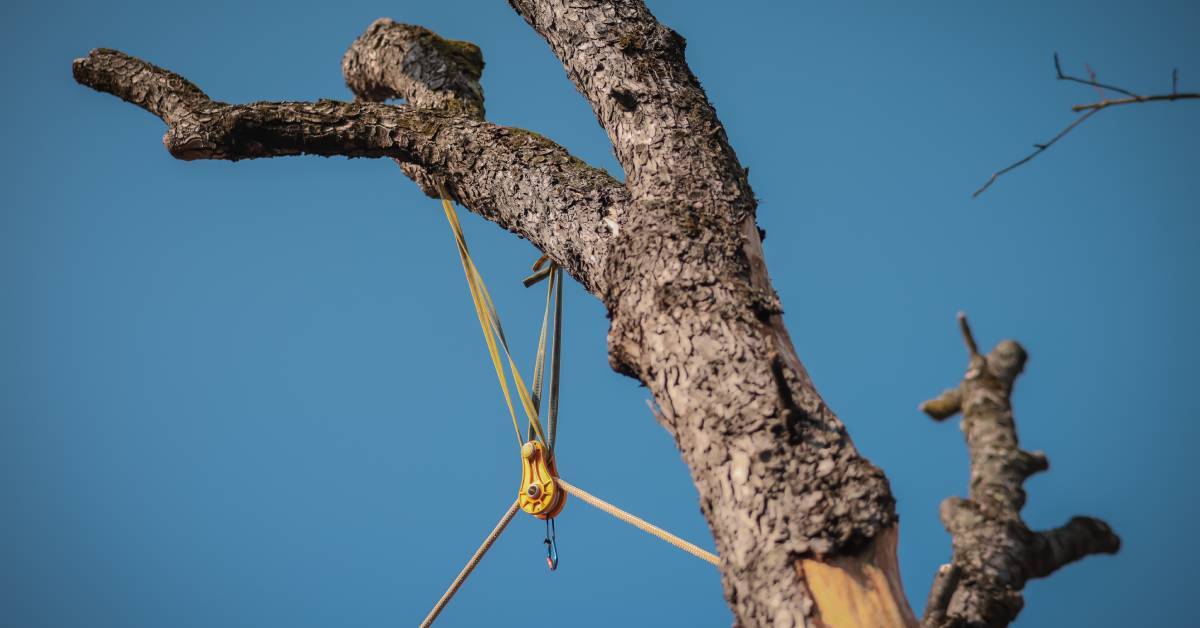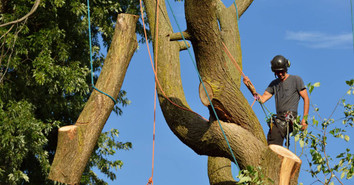Lowering heavy branches can transform from a challenging task into a safe and efficient process when you know the proper techniques. Think about it: a massive branch hovering overhead, poised to come down. Without safe rigging techniques, it’s easy to lose control of the situation, risking damage to property, injuries, or worse.
Rigging isn’t just about brute force or fancy tools. It’s about combining strategic planning, smart rigging setups, and the confidence to take on those hefty limbs without flinching. This guide takes you step by step through practical methods that keep safety at the forefront while empowering you to handle even the biggest branches.
Whether you’re working solo or with a team, these techniques will help you handle the load efficiently and stay in control every step of the way. Grab your gear, and let’s tackle those heavy branches together!
Assess the Tree and Environment
Walk around the tree and identify potential hazards, such as dead or cracked branches that could break off unexpectedly under pressure. Take note of objects nearby, like power lines, buildings, vehicles, or fences, that might be at risk during the task. Consider the stability of the ground if equipment needs to be set up, and plan a clear escape route for emergencies.
This initial evaluation allows you to plan your cuts and rigging in a way that minimizes surprises later. By scanning each element thoroughly and planning ahead, you set the groundwork for a smooth, controlled operation.
Create a Safe Drop Zone
Mark out a drop zone using cones, flags, or rope so there’s no confusion about which area to avoid. Before starting, clear the area of tools, equipment, or any debris that might create risky obstacles. Ensure everyone on-site understands where the danger zone lies and strictly avoids entering it during the rigging process.
The landing zone should be large enough to accommodate the widest and longest branches without risking accidental damage to nearby property. Taking this proactive step helps you stay organized, while also giving you peace of mind when it’s time to bring down those heavy limbs.

Choose the Right Tools for the Job
Using the right tools can make all the difference when it comes to safe rigging. A setup involving blocks and pulleys allows you to control heavy branches in a steady, predictable way. Don’t forget the rigging line, either! Make sure you’re using ropes, carabiners, and other hardware that are rated appropriately for the load you anticipate.
Smaller branches may only need basic tools, but heavier sections will often require more advanced setups to handle the increased weight. Having multiple rigging tools on hand gives you flexibility to adapt if something unexpected arises.
Select Strong Anchor Points
Anchor points are the backbone of safe rigging. Choose a stable, reliable anchor point above the target branch for precise control during the lowering process. Look for healthy, solid branches or the trunk itself to serve as attachment points, avoiding dead or weak limbs that might break under load.
Test the anchor point with light tension before starting, and make adjustments if it shows any signs of instability. Keeping the anchor high above the branch being cut helps reduce the risk of unpredictable swings or jerky movements during its descent.
Maintain Proper Body Positioning
Where you stand and how you position your tools play a big role in staying safe. Keep yourself at an optimal distance from the branch being cut, far enough away to avoid falling debris but close enough to maintain control. Ensure your footing is stable and use a harness if climbing is necessary.
Place tools like saws or ropes within easy reach but outside the drop zone so they don’t end up damaged or causing unnecessary risks. Good positioning during every phase of the process saves time and energy while also helping you work more confidently.
Use Strategic Cutting Techniques
How you make cuts determines how well the branch stays under control when it starts moving. Begin by trimming away smaller, obstructing limbs to avoid complications during the main lowering process. Use an undercut on the base of the branch to prevent tearing as it comes away from the tree.
Follow up with a top cut to fully release the branch while using your rigging system to guide its descent. Paying attention to the cutting order and method ensures the process remains smooth and predictable. Clean, deliberate cuts are easier to manage and less likely to result in sudden, hazardous movements.
Monitor Rope Tension Closely
Maintaining the correct rope tension throughout the process helps you control branches as they come down. Too little tension makes the branch unstable, while too much can stress your rigging system unnecessarily. Tools such as rope brakes or friction devices allow for smooth adjustments while handling heavy loads.
Keep an eye on the tension level at all times and communicate with your team to ensure coordination when adjustments are necessary. Avoid releasing the tension too quickly, as it could result in dangerous, abrupt swings. A steady hand combined with the right tools allows for precision as you guide branches to the ground.

Utilize Blocks and Pulleys for Heavy Loads
Large branches require additional tools to handle their weight effectively. As we briefly mentioned earlier, blocks and pulleys distribute weight across the rigging system, providing more control and reducing physical strain. Attach a sturdy block to your anchor point and run your rope through it to create a simple pulley system.
This setup helps you manage even the most challenging loads with finesse, rather than relying solely on manpower. Work slowly and keep communication open to avoid sudden movements. Checking equipment beforehand ensures that each element of the system is strong enough to handle the branch safely.
Communicate Effectively With Your Team
Clear and consistent communication keeps everyone safe and the operation running smoothly. Use standardized signals or phrases to prevent miscommunication, especially during critical moments. Before starting, go over the plan with your team and confirm who is responsible for each step of the process.
Regular check-ins at key points help identify potential issues early and allow for course corrections as needed. If something doesn’t look or feel right, don’t hesitate to speak up and pause the work until the concern is resolved. A well-informed, coordinated team can solve problems faster and with fewer risks.
Closing Thoughts
Lowering heavy branches can be a highly rewarding task when you step into the process equipped with the right safety techniques and mindset. The difference between a stressful project and a smooth operation often comes down to preparation and staying adaptable as you work. Every tree, branch, and job site brings its own unique challenges, which makes every experience an opportunity to grow your skill set.
Think of rigging as both a science and an art. The tools and techniques are important, yes, but so is the ability to read the situation, make quick decisions, and trust your instincts. With time and practice, you’ll build confidence in your ability to handle whatever comes your way.

